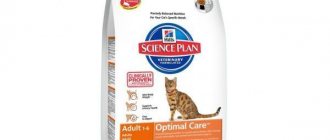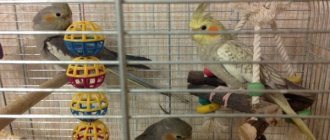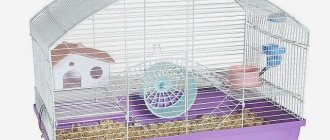/ Hamsters / How to choose the right cage for a Djungarian hamster
0
3133
Article rating
A hamster is ideal as a pet for those owners who want to have someone small and fluffy nearby, but are not ready to walk it on demand and educate it. But this does not mean that the rodent does not need your love and care. It is very important to provide him with a decent home, which would be fully prepared and equipped with the necessary parts for the rodent's arrival at your home. A cage for a Djungarian hamster - how not to make a mistake with the choice and properly arrange the room by calculating the correct dimensions?
Djungarian hamster cage
Dwelling size
One of the distinguishing features of the dzhungarik is its love of solitude. There is no need to house a dzhungarik animal with its relatives, as they may start to fight for territory: the consequences threaten to be sad. However, such a hamster also has a mobile character, so the size of its house requires sufficient space. The animal needs to run so as not to lose shape, so that it does not have problems with excess weight. What parameters should a cage for Djungarian hamsters have:
- height of at least 30 cm, two-story structures are also welcome;
- pallet area – about 35 by 55 cm, no less;
- horizontal rods with a distance of 1 cm between them.
Interior elements such as an internal house and wheel, drinking bowl and feeder are mandatory for the life of hamsters. Stairs and tunnels are at your discretion. They are easy to assemble with your own hands. Let's take a closer look at all the elements of the future home for the dzhungarik.
Overall dimensions of the hamster house
As a rule, the size of the cage depends on the type of rodent, since each subspecies has its own needs at the genetic level. For example, for Syrian hamsters it is recommended to purchase cages whose size ranges from 30*30 to 40*40, while for Djungarian hamsters the cage size should be slightly larger.
This is due to the fact that hamsters of the Dzungarian breed in the wild are able to run a much greater distance than rodents of the Syrian breed, which means they need a larger cage.
Spacious cages provide the hamster not only with freedom of movement, but also with his “personal territory”, which creates psychologically comfortable conditions for the pet.
Multi-storey apartments with many tunnels, staircases and labyrinths will be of interest not only to the hamster, but also to its owner, because it is very interesting to watch from the side the little furry, who every now and then pulls something around the cage or is studying the objects of his interior.
But not everything is as good as it seems at first glance. Yes, it is very exciting for a hamster to roam the expanses of his house, which is of impressive size, but the pet owner will have to spend time dismantling the barricades in order to carry out routine cleaning of the cage. Therefore, before you acquire huge cells, think carefully.
Another important aspect of choosing a cage is the bars, or rather the distance between them. It should be a maximum of 25 mm. It is believed that rodents like apartments with horizontal bars more, since they have additional ladders on which to crawl.
It is also important to visually inspect the rods for deformation or curvature. Djungarians are nimble, flexible rodents, so given the slightest opportunity to leave their house, they will definitely take advantage of it, but you will have to look for your pet throughout the apartment, which is not so easy.
As for the bottom of the house, it can be low with a retractable mechanism and high. The latter is somewhat inconvenient, because in order to clean the cage, you will need to get the hamster and hold it in your hands, that is, you need outside help. Whereas the low bottom can be safely pulled out and washed, without worrying that the hamster will escape.
High bottom apartments are perfect for breeders who want to breed hamsters. Babies who constantly crawl out of their cozy nest, thanks to the high sides, will not be able to fall out of the cage.
Some practice keeping dwarfs in an aquarium or terrarium, but this is not very good for both the rodent and its owner. Firstly, there is no good ventilation in the aquarium, therefore the microclimate is disturbed and the pet can often get sick. And secondly, it is much more difficult for a person to wash and clean the aquarium.
Exterior of the home
As mentioned above, it is important to choose rare rods, made of durable material, preferably metal. This will deprive the hamsters of the chance to get out. The quality of the doors is no less important - good and durable, with a reliable deadbolt. As for the roof, the owner prefers an option that he can easily fold back with his own hands - to facilitate the process of cleaning the cage. But keep in mind that it will not be difficult for a hamster to open such a lid either. You need to look for a compromise between convenience and safety.
The question of the color of a rodent’s home, it would seem, is not fundamental. The thing is that hamsters love to chew on rods, and if there is paint on them, the animal can be poisoned. For this reason, painting the grilles is not recommended. And, if you want to add some color to your house design, experiment with the roof of a Djungarian hamster cage.
Djungarian hamster: care
Hamsters are an optimal alternative to large pets - dogs, cats, birds. Small in size, they fit into compact cages that can be placed anywhere in the room. They do not need to be brushed, walked or bathed daily.
Some animal lovers may have a question: what are the benefits of a hamster? You can’t pet him, you can’t run with him (unless he escapes from the cage and you have to organize a hunt for the cunning pet), he doesn’t purr and doesn’t know how to whine cheerfully.
What should the pallet be like?
This structural detail also comes in several types. Why do owners of Djungarian hamsters not need to give preference to the retractable option? These individuals usually choose a corner opposite the inner house as a toilet area. In a situation like a sliding tray, the hamster will often “walk” under this structure.
Another argument in favor of a solid bottom is its depth, which is absent in a flat retractable one. A little lover of running will scatter the filler, and therefore only high walls above the bottom will save you from frequent cleaning.
Where should the cell be?
In addition to size, the location of the pet’s “housing” is also of great importance, because both its activity and life expectancy will depend on this. First of all, you should avoid:
- places where there may be direct sunlight;
- batteries and heating devices;
- drafts;
- unheated rooms where the hamster can freeze.
Before setting up a cage for a hamster, you should remember that there should be no TVs or monitors near the baby, and you should not keep your pet in places where the lighting is too bright and noisy. The pet is very sensitive to any sound, so any shouts and fuss will have a stressful effect on the rodent.
Floors and compartments
It shouldn't be boring in a cage
Whether additional floors are needed in a cage for a Djungarian hamster depends on the character of your pet. Representatives of the breed love to run, but are lazy to climb. However, each individual has its own preferences, so it’s worth trying to install another floor. So, what requirements need to be taken into account in this matter?
- The height of one span should be no more than 25 cm - otherwise the risk of injury increases.
- It is more convenient to make the floor plastic rather than lattice - so that neither the rodent nor its food falls through.
- Give preference to cages with floor height adjustment functions.
Experts recommend, taking into account the specific character of the dzhungarik, to equip its home with a tunnel or enclosure - instead of additional floors.
Choosing a cage for a hamster
It is better for a hamster to purchase a one-story spacious cage measuring 30 cm by 50 cm. In large cages, hamsters have room for an active life. A small cage causes stress, obesity and the development of cardiovascular diseases in rodents.
If you decide to buy a two-story cage, then you need to choose one in which you can adjust the height of the floors. Usually the hamster likes to walk on the lower floor, and prefers to sleep on the upper floor.
Also, when buying a cage for dwarf birds, you need to take into account how many animals will live in it. Three-story cages are suitable for a family of hamsters. Two-story ones are chosen by the owners of one or two dungarians.
You can purchase a cage with transparent plastic walls. But it is difficult to hang accessories in such a cage and the animal will not be able to climb up and down on the plastic walls.
You can also make a cage with your own hands. It can be wooden, ceramic, cardboard, plexiglass or plastic. But you need to take into account that pathogenic organisms can form in wood and cardboard.
In plexiglass cages there is no way to climb the walls. Therefore, the best option is a homemade home made from a food container with walls made of metal lattice.
Mandatory and optional accessories
In addition to the necessary components of the Djungarian hamster cage, there are secondary interior items. For example, you can’t do without a house - it will serve as a pet’s bedroom, a place of solitude. The strength of the material is also important here - choose wood or ceramics. A hamster will not be able to disassemble a well-built house. Calculate the dimensions so that it does not get stuck in the openings. You can make a flooring or nest inside. Place the feeder heavy, otherwise the dwarf will turn it into another toy. Alternatively, you can place it outside. The same goes for the drinking bowl. Opt for the automatic option. Buy a wheel with a diameter of about 15 cm with a flat surface inside, otherwise the hamster’s paws may get stuck in the structure.
A caring owner will probably want to decorate the pet’s home and equip it with additional facilities to diversify the hamster’s leisure time. The tunnel is a great option to keep hamsters occupied and provide them with some exercise. But the habit of gnawing everything can be transferred to a special object - a stick-gnaw. A walking ball is suitable as a toy. Just do not put cotton wool in the cage under any circumstances - the animal can swallow it!
What can't you do without?
So, you have chosen a cage for your dwarf, it’s time to think about what essential items he needs.
Here's what should be in a hamster's cage:
- Litter. You can put a special filler or sawdust in the tray. Don’t even think about using hay as bedding – it becomes limp and smells bad due to the fluffies’ secretions.
- Hanging drinking bowl with ball.
- Food bowl: shallow, cylindrical so that it does not tip over.
- Food. Recent owners of rodents do not know what they can give them as food. Dry hay, grains, seeds, and fresh herbs are suitable. You can buy special food and treats in pet stores.
- Wood twigs. The hamster needs it to grind down its incisors, which grow throughout its life.
- A jar of sand with low walls: the hamster will clean its fur in it.
If you have a family of rodents, they need a love nest. The animals will build it themselves from sawdust and scrap materials. Your task is to unobtrusively throw them pieces of soft fabric or thin paper.
Rice. 3 – The drinking bowl should not be hung high
Where to buy or how to make it yourself
How much does a finished house cost and where can I buy it? You can buy a home for a dwarf at almost any pet store. The average price is quite affordable: it all depends on the material. If you have the necessary skills, you can make a house for hamsters with your own hands according to instructions on the Internet.
- One of the simple options is a coconut house. The liquid is drained from the nut, then holes are carefully drilled of such a diameter that the hamster can freely crawl through them - at least 5 cm. If necessary, the coconut is washed from the inside and undergoes a grinding process. It may be difficult to remove the pulp. To make the process easier, the fruit should be placed in the freezer overnight - in the morning it will separate from the coconut peel itself. All that remains is to scrape it off with a chisel.
- To make a home from wood or plywood, you will need a piece 4 cm thick. Next, four boards are cut out and sanded - two 12 cm each and two 14 cm each. A 6 cm hole needs to be drilled in one of the smaller ones, and future windows in the long one. All parts are connected to each other.
You can make a labyrinth by hand from cardboard tubes soldered crosswise. The rodent will appreciate such an attraction. As for the stairs, plywood or wood is suitable for it. The main thing is proper polishing: the animal should not be scratched. Using available materials, it is quite possible to make pipes and labyrinths for the cage yourself. Toilet paper rolls, packaging wrappers, and shoe boxes will do. It all depends on your imagination!
Running wheel and other toys
Since your rodent likes to lead an active lifestyle, having a wheel in the home will have a very positive effect on your pet’s health. First of all, the baby will be able to lose excess weight, which the pet is prone to, and fill his day with something interesting. Many owners note that even with a huge selection of toys, the hamster entertains itself with the wheel, especially if it is left alone in the room. It is only important to choose the right wheel for your pet so that it does not make noise when rotating and does not frighten your pet.
In addition, the rodent will need chewing toys on which it will grind its teeth. These can be either treats in the form of spikelets, or inedible things that are useful for growing teeth.
An excellent option for leisure will be tunnels through which your pet will run carefree, as well as bridges that you can also chew on. Ordinary cardboard tubes are also suitable for playing; they cost a pittance, but will be a great pleasure for the hamster.
How to clean it properly?
Regular cage cleaning affects not only the health and comfort of the pet itself, but also the atmosphere in the owner’s home. Although Djungarians are small animals, their waste products quickly begin to emit unpleasant odors if they are not removed in time.
Every day, a responsible owner must carry out spot cleaning of the hamster’s home, that is, remove spilled food, change water, and remove waste products. The filler is completely replaced every two weeks.
The following steps should be followed when cleaning your pet's home:
- put the hamster in a temporary home, even an ordinary jar will do;
- discard the filler from the pan, but leave a handful of the old contents;
- Remove only rotten foods from your hamster’s supplies, which can poison him; do not touch his “pantry” completely, as he has tried very hard to accumulate a large supply, and will be stressed if he discovers it is missing;
- rinse the tray thoroughly with warm water using a sponge, or you can use baby shampoo;
- Wipe all interior items in the cage and bars with a damp cloth;
- Wipe the tray and rods dry, put all the attributes in place, mix fresh litter with the remaining handful of old litter and pour it into the cage.
SAVIC SPELOS XL METRO
The unusual design of the cage for hamsters is presented in the form of a plastic two-tier box. On the second level there is a figured shelf, which has holes for a drinking bowl, wheels and a feeding bowl. The transparent tunnel comes out and is strong enough for the hamster to chew through it. The box itself is quite large - 59*37*26, which allows you to purchase a similar product for the Syrian hamster.
Pros:
- Large and roomy box;
- Suitable for large hamsters;
- Good equipment;
- High animal safety.
Apartment in a cage
It is recommended to place a small house in the hamster’s apartment, which will replace his mink and become an excellent refuge for the pet. In this house, the fluffy will sleep, hide from the intrusive glances of his owner’s guests or his family members, and also store food supplies.
As for the latter, this is not always good, because a fungal infection can spread in food deposits, so you should systematically empty the rodent's warehouse.
Such a small shelter is a very important element of a hamster’s interior. Females feed their younger generation in it. However, not every hamster uses a house for breeding. Some of them make burrows right in the “floor covering,” that is, in the sawdust that litters the bottom of the cage.
I would like to add that it is not worthwhile to arrange the house. Hamsters will independently decorate their shelter in a way that makes them more comfortable and convenient.
Important points
The following recommendations will help provide your rodent with a comfortable and safe home:
- The cage bars should be positioned horizontally. You can hook the feeder and drinker to them and hang toys. The animal will climb walls and ceilings, using the home as a simulator.
- There should be a distance of 1 cm between the bars, then the animal will not get out of its house.
- The rods should not be painted. The hamster will chew paint that is harmful to health.
- The rodent's home must be equipped with good ventilation so that an unpleasant odor does not accumulate in it.
- In plastic models, sharp parts should not stick out, otherwise the animal may get hurt or chew them off.
- Choose a cage that is easy to remove and easy to clean.
- The dzhungarik's cage must be equipped with strong doors and a good lock. Hamsters are very smart, they can open the door on their own and escape.
A cage for a dwarf should be convenient, comfortable and safe. Only in a quality home will a rodent be healthy, alert and active.
TRIOL STUDIO
The beautiful cage design has dimensions of 33*21*23. It comes complete with a house, special components for forming a labyrinth, a drinking bowl, a feeder, and a wheel. The cage is equipped with a comfortable handle and a secure door that the hamster cannot open. The cage is conveniently disassembled (removable bottom), which makes cleaning and cleaning easier.
Pros:
- Convenient cage-case;
- Good equipment;
- Quality materials;
- Easy cleaning and maintenance.
DARELL TERRY-1 ECO
The rectangular cage has dimensions 37*26*18. It is well suited for installation on a table or bedside table. Thanks to the optimal height of 18 cm, many accessories for the active life of a hamster can be placed inside the cage. The second floor allows you to expand the animal’s activity area, and the horizontal rods allow you to climb on them.
Pros:
- Good capacity;
- Optimal equipment: drinking bowl, wheel and house;
- The door is located in the center of the roof;
- Durable and reliable.
Minuses:
- Suitable for a medium sized hamster.
Material
Cages are made of metal or plastic, or a combination of these materials (plastic tray and metal grid). They do not have any advantage over each other, so the choice should be based on the size of the mesh cells and the breed that you are going to breed.
Djungarian and Chinese hamsters are small enough to squeeze between metal bars, but the Syrian Homa will be equally safe behind a metal grill or a plastic one.
In addition, plastic models often have a second tier and can be equipped with tunnels running outside the main house. All this makes the product more expensive, but the choice here depends solely on your financial capabilities. Yes, an animal cannot do without accessories, but they can always be purchased separately.











